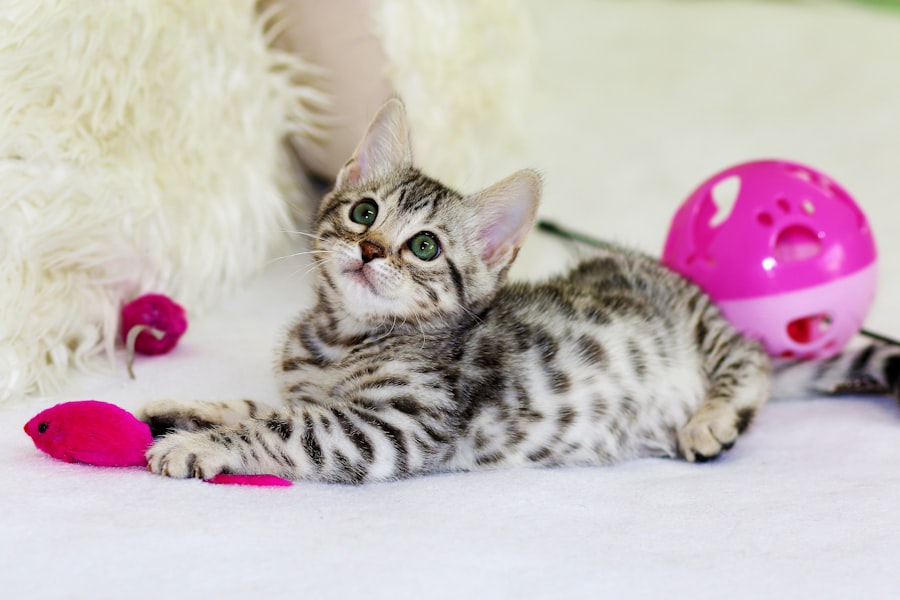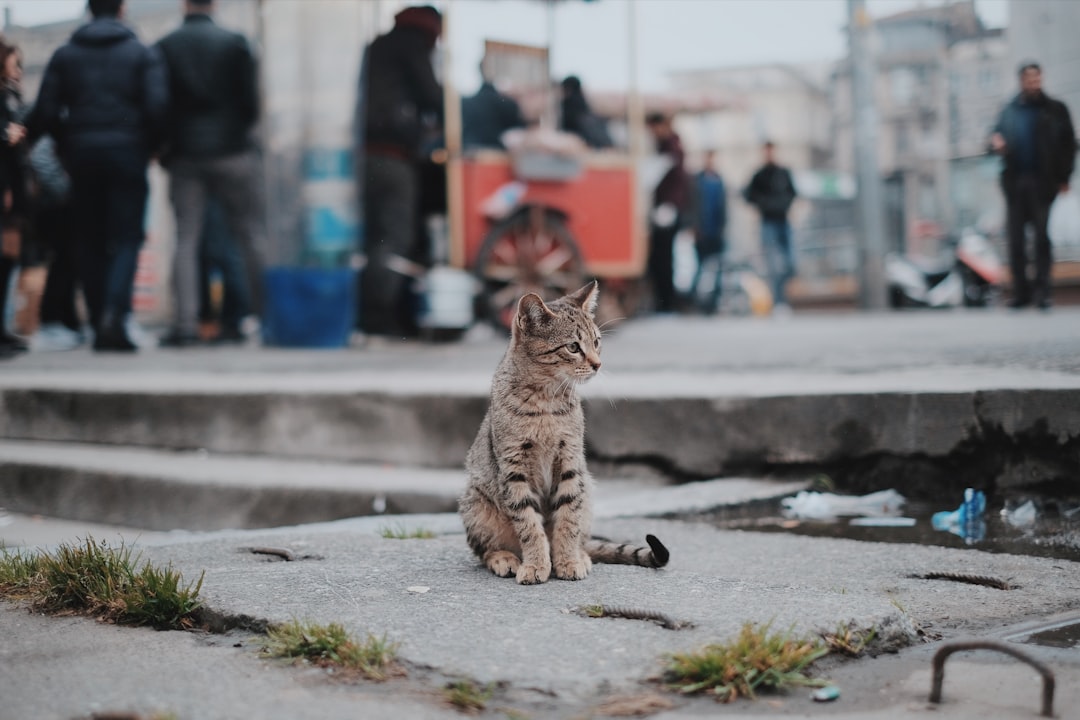Feline hyperactivity, also known as feline ADHD, is a condition in cats that is characterized by excessive energy, impulsivity, and difficulty in focusing. Just like in humans, cats with ADHD may exhibit behaviors such as constant movement, inability to stay still, and a short attention span. This can make it challenging for cat owners to manage their pet’s behavior and can lead to frustration for both the cat and the owner.
Feline hyperactivity can be caused by a variety of factors, including genetics, environment, and underlying medical conditions. Some cats may be genetically predisposed to hyperactivity, while others may develop it as a result of a stressful or stimulating environment. Additionally, certain medical conditions, such as hyperthyroidism or neurological disorders, can also contribute to feline hyperactivity. Understanding the underlying causes of feline hyperactivity is crucial in developing an effective management plan for affected cats.
Key Takeaways
- Feline hyperactivity is a condition characterized by excessive energy and restlessness in cats.
- Signs of ADHD in cats may include excessive meowing, destructive behavior, and difficulty in focusing on tasks.
- There is no specific test for ADHD in cats, but a veterinarian can rule out other potential causes for hyperactivity.
- Managing feline hyperactivity involves providing mental and physical stimulation, creating a structured routine, and using interactive toys.
- The environment plays a crucial role in managing feline hyperactivity, with factors such as space, noise levels, and social interactions impacting a cat’s behavior.
Signs and Symptoms of ADHD in Cats
Cats with ADHD may exhibit a range of signs and symptoms that can be challenging for owners to manage. Some common signs of feline hyperactivity include excessive meowing or vocalization, destructive behavior, such as scratching furniture or walls, and difficulty in settling down or relaxing. Additionally, hyperactive cats may have difficulty in focusing on tasks or following commands, and may constantly seek out stimulation and play.
Other signs of feline hyperactivity may include impulsive behavior, such as jumping on and off furniture or countertops, and difficulty in maintaining a regular sleep schedule. These behaviors can be disruptive to both the cat and the owner, and can lead to stress and frustration for all involved. Recognizing the signs and symptoms of feline hyperactivity is the first step in developing a management plan to help affected cats.
Can Cats Be Tested for ADHD?
While there is no specific test for feline ADHD, veterinarians can conduct a thorough physical examination and medical history review to rule out any underlying medical conditions that may be contributing to a cat’s hyperactivity. Additionally, behavioral assessments can be conducted to evaluate a cat’s behavior and determine if they exhibit signs of ADHD.
During a behavioral assessment, a veterinarian or animal behaviorist may observe the cat’s behavior in various environments, evaluate their response to stimuli, and assess their ability to focus and follow commands. This can help determine if a cat’s behavior is consistent with feline hyperactivity and can guide the development of a management plan to help the cat and their owner.
Managing Feline Hyperactivity: Tips and Strategies
| Tip/Strategy | Description |
|---|---|
| Interactive Toys | Provide toys that encourage physical activity and mental stimulation. |
| Regular Playtime | Schedule daily play sessions to help burn off excess energy. |
| Environmental Enrichment | Create a stimulating environment with climbing structures and hiding spots. |
| Training and Obedience | Teach basic commands and provide mental challenges through training. |
| Consult a Veterinarian | If hyperactivity is excessive, seek professional advice for potential underlying issues. |
Managing feline hyperactivity can be challenging, but there are several tips and strategies that can help cat owners effectively manage their pet’s behavior. Providing regular exercise and mental stimulation is crucial in helping hyperactive cats release excess energy and focus their attention on appropriate activities. This can include interactive play sessions, puzzle toys, and environmental enrichment to keep the cat engaged and entertained.
Creating a structured routine for feeding, playtime, and rest can also help hyperactive cats feel more secure and reduce their impulsivity. Additionally, providing a safe and stimulating environment with plenty of hiding spots, perches, and scratching posts can help cats feel more secure and reduce their need for constant stimulation.
The Role of Environment in Feline Hyperactivity
The environment plays a significant role in the development and management of feline hyperactivity. Cats that are exposed to stressful or stimulating environments may be more prone to developing ADHD-like behaviors. Loud noises, changes in routine, lack of environmental enrichment, and overcrowding can all contribute to feline hyperactivity.
Creating a calm and predictable environment for hyperactive cats is crucial in helping them feel more secure and reducing their impulsivity. This can include providing quiet spaces for the cat to retreat to, minimizing exposure to loud noises or sudden changes, and providing plenty of opportunities for mental and physical stimulation.
Additionally, reducing sources of stress in the environment, such as conflicts with other pets or lack of access to resources like food and water, can help reduce a cat’s hyperactivity. By creating a supportive environment for hyperactive cats, owners can help their pets feel more secure and reduce their ADHD-like behaviors.
Using an ADHD Workbook for Cats

An ADHD workbook for cats can be a helpful tool in managing feline hyperactivity. These workbooks typically include exercises and activities designed to help cats focus their attention, release excess energy, and develop impulse control. This can include interactive games, puzzle toys, and training exercises that engage the cat’s mind and body.
Using an ADHD workbook for cats can provide structure and routine for both the cat and the owner, making it easier to manage the cat’s behavior and provide appropriate outlets for their energy. Additionally, these workbooks can help strengthen the bond between the cat and their owner through positive reinforcement and interactive play.
Seeking Professional Help for Hyperactive Cats
If a cat’s hyperactivity is significantly impacting their quality of life or causing distress for the owner, seeking professional help from a veterinarian or animal behaviorist is crucial. These professionals can conduct a thorough assessment of the cat’s behavior, rule out any underlying medical conditions, and develop a tailored management plan to help the cat and their owner.
Professional help may include behavior modification techniques, environmental modifications, and in some cases, medication to help manage a cat’s hyperactivity. Additionally, professionals can provide guidance and support for owners in managing their pet’s behavior and improving their overall well-being.
In conclusion, feline hyperactivity is a complex condition that can significantly impact a cat’s behavior and well-being. By understanding the signs and symptoms of feline ADHD, creating a supportive environment, using appropriate management strategies, and seeking professional help when needed, owners can effectively manage their pet’s hyperactivity and improve their quality of life.
If you’re curious about whether cats can have ADHD, you might be interested in learning more about ADHD testing for humans. Check out this article to explore the different methods and approaches to diagnosing ADHD in people. Understanding how ADHD is diagnosed in humans can provide insight into the possibility of similar conditions in animals like cats.
FAQs
What is ADHD in cats?
ADHD, or Attention Deficit Hyperactivity Disorder, is a neurobehavioral disorder that affects a cat’s ability to focus, control impulses, and regulate energy levels.
Can cats have ADHD?
While cats can exhibit hyperactive or impulsive behavior, they do not have the same ADHD diagnosis as humans. However, they can have similar symptoms that may be indicative of other underlying issues.
What are the symptoms of ADHD-like behavior in cats?
Symptoms of ADHD-like behavior in cats may include excessive hyperactivity, impulsivity, difficulty focusing, and trouble with impulse control.
What could be causing ADHD-like behavior in cats?
ADHD-like behavior in cats could be caused by various factors such as stress, anxiety, medical conditions, or simply their natural personality traits.
How can I help manage my cat’s hyperactive behavior?
To help manage a cat’s hyperactive behavior, it’s important to provide plenty of physical and mental stimulation, create a calm and structured environment, and consult with a veterinarian to rule out any underlying medical issues.














